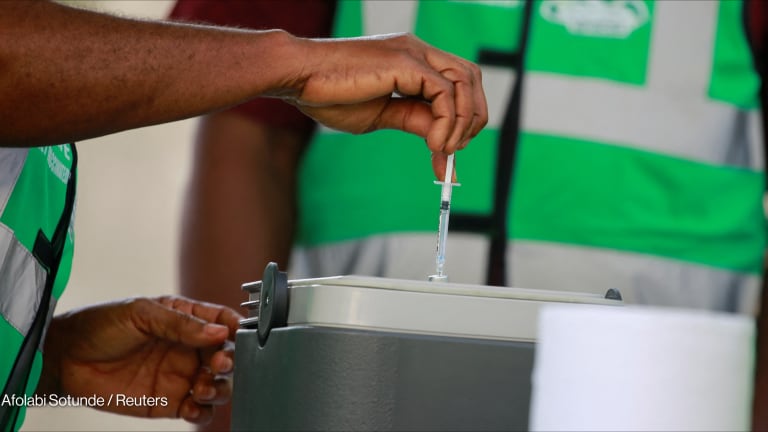
The COVID-19 pandemic has made clear the stark deficits in global health care worldwide, prompting efforts to better advocate for and support front-line health workers. Yet according to experts, hospital and health facility cleaners may have been left behind.
“Cleaners have really been the neglected workforce in the pandemic,” said Hayley Schram, WASH research assistant at Global Water 2020, an initiative focused on water access and security. They are often not seen as part of the core group of health care facility staffers, she added, “yet the work of the cleaner can literally mean life or death.”
Each year, over 1 million deaths are linked to unclean births, while a newborn dies from infection or another preventable cause every minute.
Infection prevention and control, or IPC, are part of patient safety, and patient safety is part of quality of care, said Wendy Graham, a professor of obstetric epidemiology at the London School of Hygiene & Tropical Medicine. As the stewards of IPC, cleaners by default play an important role in patient care.
The challenges cleaners face
Often — even prior to the pandemic — cleaners haven’t been provided with the resources and support that might be afforded to others in the health care workforce.
Gita Acharya is a cleaner at a health facility in Nepal’s Bardiya district. She spends her days collecting waste, cleaning rooms, and sanitizing medical equipment. While historically there have been challenges with a lack of sanitation and hygiene facilities — until a recent intervention from international humanitarian federation Terre des Hommes, the facility only had one toilet — lately it’s the low level of personal protective equipment preventing her from doing her job as efficiently as possible.
“You need to create a culture that means cleaning after the pandemic is not going to go back to a lower-level activity.”
— Wendy Graham, professor of obstetric epidemiology, London School of Hygiene & Tropical MedicineA lack of PPE can further expose cleaners to occupational injury or illness, Schram said. According to U.K.-based research, the risk of contracting COVID-19 was higher among cleaners than intensive care workers, possibly due to differences in PPE.
Other challenges Schram listed included low wages, a lack of job descriptions, and insufficient supplies — almost half of health care centers in the lowest-income countries didn’t have basic water services — while Graham highlighted issues of low recognition and respect.
“[Cleaners] have no voice, which means they don’t speak up when they run out of bleach, which means sometimes they’re managing mops [that are] basically spreading disease rather than removing pathogens,” Graham said. The perception of the job as low-skilled could be to blame, she added.
That same perception could feed into cleaners often receiving little or no training. In Bangladesh, India, Gambia, and Zanzibar, research found that less than a third of 56 health care facilities analyzed delivered formal training to cleaners.
Yet the World Health Organization has stated that training not only safeguards the health of cleaners and patients, but improves staff retention by contributing to a set career path through education and certification requirements.
While existing initiatives include The Soapbox Collaborative’s Training in Environmental Hygiene and Cleaning in Healthcare, or TEACH CLEAN — created to improve environmental cleaning services in health facilities through a free package of materials — and WHO and UNICEF’s Water and Sanitation for Health Facility Improvement Tool, or WASH FIT — a risk-based approach for improving WASH and health care waste management services — universal rollout is lacking.
Although Acharya has completed WASH FIT training, she said that IPC training in particular would help decrease her risk of contracting an illness.
COVID-19 as a catalyst
The hope is that COVID-19 will be an agent for change for improved recognition of cleanliness and hygiene, Graham said, adding that she’s witnessed an increase in respect for and recognition of cleaners. There’s also been an uptick in demand for TEACH CLEAN, and WHO is planning to provide an updated universal package in the next few years, she said.
The attention that COVID-19 drew to deficits in health care facilities could mean further improvements for cleaners. Margaret Montgomery, technical officer at WHO, said it’s too early to predict if any COVID-19 investments will address these longer-term issues but added that there have been some promising signs.
Ethiopia’s Ministry of Health mobilized $5 million to support IPC and WASH activities in 74 hospitals treating COVID-19 patients, while Madagascar has leveraged COVID-19’s challenges to improve waste management in primary health care facilities.
“We are now at a critical juncture to transition these immediate actions to systematic improvements, monitoring, and funding — all amidst a global recession,” Montgomery said.
The long haul
Recognizing cleaners as part of the health care workforce will be key to such efforts, Graham said. Failure to do so means cleaners likely won’t benefit from training and other changes being proposed in the name of quality IPC as a result of COVID-19, she added.
“You need to create a culture that means cleaning after the pandemic is not going to go back to a lower-level activity,” she said, adding that a big part of that is addressing the issues of cleaners’ social status.
More from WASH Works:
► The war being waged against WASH facilities
► Robots, drones, and AI: The new technology making waves in WASH
In Haiti, safe water nonprofit One Drop has been working to elevate the voice of cleaners at the health facility, community, and ministry levels by conducting mural and song workshops. In Burkina Faso, it worked on a touring exhibition of photos created by cleaners and other health care facility workers themselves.
Cleaners should be included as key stakeholders in pandemic recovery plans and in preparations for the next pandemic, Schram said. Acharya said she’d like to be a part of any decision-making processes so she can share her challenges and learnings as a cleaner.
While figures exist for how many health professionals there should be for each group of care seekers, no such figures exist for cleaners, Montgomery said. The “WASH in Health Care Facilities: Global Baseline Report 2019” found that only four of the surveyed countries had sufficient data on cleanliness, cleaning staff, and cleaning protocols, despite it being critical for decision-making.
“Cleaners and cleaning really needs to be the narrative we keep reminding people of,” Graham said. “It’s got to come out of the corridors of WHO, U.N. [United Nations] agencies, and big NGOs and get right the way down to where cleaners are facing risks themselves.”
Visit the WASH Works series for more coverage on water, sanitation, and hygiene — and importantly, how WASH efforts intersect with other development challenges. You can join the conversation using the hashtag #WASHWorks.







